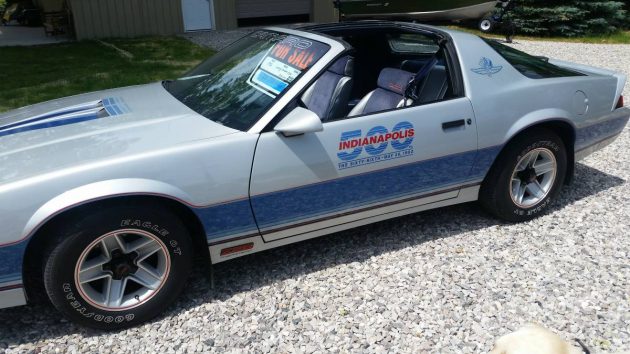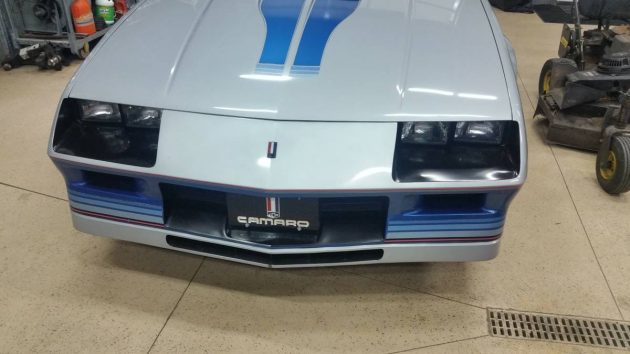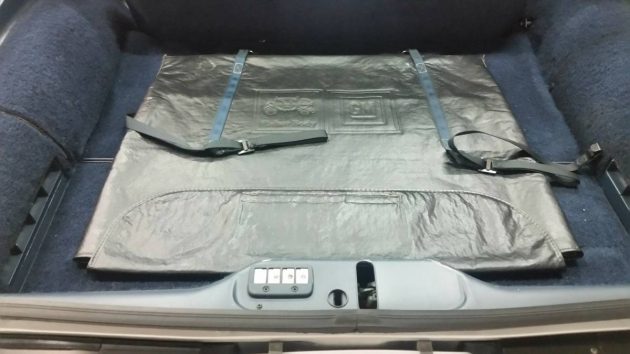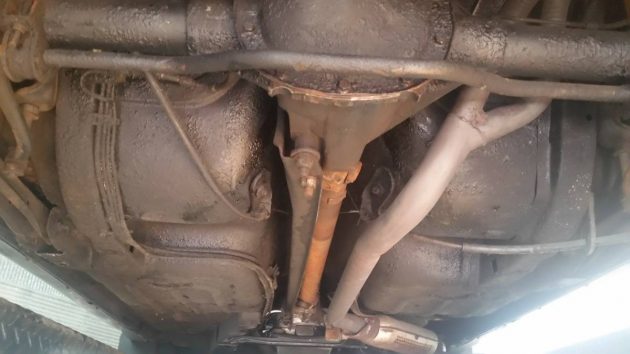For many of us, watching the annual Indianapolis 500 has been a ritual. As the race grew in popularity from its inception, more and more people took time out of their lives to listen to, watch on television, and, for a lucky few, attend what many felt was the greatest race in motorsports. For years, tickets were almost impossible to come by, and automobile enthusiasts from all over the world had a trip to the Indy 500 on their bucket list. Sadly, the race no longer seems to have the luster it once had. What was once as American as apple pie and the flag is now almost just another stop on the circuit for the Verizon Indy Car Series. Luckily for us, there are a number of reminders still around from when the race was still great. This 1982 Camaro Indianapolis 500 Pace Car, found on Craigslist in Elk Rapids, Michigan, looks like it just rolled off the racetrack. With an asking price of $10,500 or best offer, this Camaro is an expensive way to relive the magic.
For those readers who are not steeped in the whole Indy pace car tradition, this is kind of a brief rundown. For years, it was an honor for a manufacturer to have one of its cars chosen to be the official pace car of the race. The pace car comes out and paces the field during cautions, and is highly visible to the fans and for everyone watching on television. For a race as big as the Indianapolis 500, this is a lot of exposure and, thus, advertising of a sort. After a while, the racetrack evolved this deal into receiving a handful of actual pace cars, often modified for power and handling, a large number of “official’s cars” that people associated with the race drove around town during what used to be a whole month of practice, qualifying, and racing, and for any support vehicles needed. The winner, of course, got to bring one home as well. Many speculate that a large amount of money changes hands too, but all’s fair in love and racing.
Of the manufacturers who have been represented, General Motors has provided the most pace cars. Of the General Motors divisions, Chevrolet reigns supreme in the number of models that have been chosen to be pace cars. Most notable were the 1955 Chevrolet Bel Air convertible, 1968 Chevrolet Camaro convertible, 1978 Chevrolet Corvette, 1982 Chevrolet Camaro, and 1986 Chevrolet Corvette. Later years found the pace car job being essentially dominated by Camaros and Corvettes, due in no small part to the speed and acceleration demands that have risen almost every year. To capitalize on this publicity, manufacturers almost always put out a pace car replica to be sold to the public. These cars were usually no more than a set of stickers, and a special paint job added to a top of the line production version. Some years the cars look better than others, and these become quite popular. Prices, driven by collectors and speculators, rise accordingly. Many people have purchased these pace car editions and squirreled them away, hoping that they will be worth a mint some day. The 1978 Chevrolet Corvette has become the most infamous of these cocooned classics, with ultra low mileage examples still popping up from time to time sporting insane prices that rapidly descend back to Earth if they want to sell the car.
With 39,000 miles on the clock, and a life in snowy Michigan spent in a climate controlled garage, you could say that this 1982 Camaro has been kept with an eye for an eventual cashing in. It has been enjoyed, and I don’t think that has taken too much of the value away. The former owner has obviously taken excellent care of it, as evidenced in the absolute mirror finish on the darker, lower sections of the body. In the pictures above, you can see the individual rocks in the driveway reflected in the paint. While we do not have pictures of the cabin, the above picture of the hatch area still shows the GM provided protective case for the T-tops in its as-delivered position.
The undercarriage shot above provides more evidence that this early third generation Camaro has lived a charmed life. When you factor in that this one has lived its life in the land of snow and salt, the condition underneath is remarkable. You also have to consider that there are few 1982 Camaros left on the roads. They were popular cars, and were often driven into the ground, hot rodded to destruction, or expired from natural causes long ago. This car still has the cross fire fuel injection system that gave mechanics fits back in the day, and was often replaced by an aftermarket manifold and a carburetor after the warranty ran out. When was the last time you saw any 1982 Camaro in a condition that even approaches this?
You have to wonder if the condition and the fact that it is a pace car edition makes it worth the $10,500 asking price. The performance is not up to modern standards for a pony car, and neither is the build quality. However, there are many people who grew up watching the Indianapolis 500, and most still have going to the race on their bucket list. Having a pace car is probably on their list of wants in life as well. This one has enough miles on it that you wouldn’t feel guilty driving it on occasion, and the price is not ridiculously stratospheric like the asking price of the ones with five miles on the odometer. It is also a moderately rare, distinctive version of the Camaro, especially in a sea of IROCs and regular Z-28s. My guess is you aren’t getting a bargain, but you likely won’t lose money in the long run. Why not enjoy a little piece of the magic from the old Indy while you can?







The end of the interesting Indy 500 pace cars, to me, ended with the Indy Racing League takeover in 1996. First Oldsmobile/Aurora and then were Chevrolet were engine manufacturers in the series, so they got the deal to provide the pace cars. It’s always been an American car, too. Dodge tried to offer a Stealth as a pace car in the 1990s, but public uproar forced them to ditch it for, I believe, the Viper prototype. Whichever manufacturer provided the pace car also provided track support vehicles including pickups, vans and tow trucks. Some of the Indy 500 support trucks are pretty cool finds.
Pace car replicas never impressed me. A pretender is always a pretender. It would have been better without the lettering on the door. If you sell a car that says Pace Car for a named race, then that better be THE car we saw on TV, not one of hundreds of replicas.
.
I always liked this body style, though in Pontiac flavor. This color combination is a bit on the boring side though.
In 1982, there was a substantial difference between the replicas and the actual pace cars. The real pace cars had aluminum block 350s which made over 250 horsepower. The replicas had either anemic 145 horse LG4 or the wheezy 165 horse Cross Fire Injection motor.
I’d be curious as to what happened to the real pace cars. I’d guess scrapped as they probably weren’t EPA compliant.
I never knew the winning driver got a car, a way better deal than losing your race car for a year if you win Daytona.
Having “official” this or that plastered on your car seems a tad tacky like expecting VIP service at gas stations or valet service at a restaurant. “Right this way Mr. Smith!”
Sorry to be a stickler, but…
There were early Camaro pace cars in 1967 and 1969, not in 1968.
I noticed that too. Good catch!
Great write-up!
Interesting trivia note: the 1982 Indy Pace Car Z28 (and perhaps all ’82 Z28s for that matter) could be ordered with a Recaro-style Lear seat with more bolstering and adjustments (see picture showing both seats from a similar period Camaro). While you could outfit your Z28 with this sweet driver’s seat, you couldn’t get the same seat for the passenger side. I can’t tell if this one has the special driver’s seat, but it makes an interesting sidebar to a car that was my high school senior year “dream ride!” Shame these first-year cars were so QC-challenged.
I was a senior then to !
Any knucklehead who bought one of these Indy replicars and put it out in the barn or a side yard thinking that their baby was going to college funded by the value of the ‘investment’ either thought too much about the car, or too little about their child.
Yup! You’d be beaten beyond recognition by an overtaxed soccer mom in a Honda Odyssey mini-van – so much so she would only hear the cry of that single exhaust with resonators for a couple seconds before blasting away out of earshot.
These cars were criticized for being slow even for the time (which ain’t good since everything was slow then). Hence, the dollar values are quite low. The “money” Third-Gen cars, to the extent that term applies, lies in the later 5.7 TPI and 5.0 TPI 5-speed cars, particularly the 1LEs and G92s.
Had one of these 82 pace cars earlier this year with less than HALF the miles of the car shown above and with condition much better than you would expect with the low miles. Carried to 3 different auctions and FINALLY sold the car for $6,500.
No money out there for these Pace Cars. This one is VASTLY overpriced!!!
My buddy has the 82 Camaro pace car with a nicely modified 305 making 280hp on a dyno to the rear wheels
I think it’s a great looking car. These third generation Camaro’s are climbing in value every year because us gen x guys / gals are buying them up. Love my Chevelle but also love our 85 Z28 Camaro.
305 crossfire,yikes. I had a 1982 Z28 305 4 barrel and a 4 speed manual . Was a nice driving car but 160 hp was just not enough power.
I have seen these cars go for as much as 20k. This one is worth 10k all day long.
The low miles are most likely due to the fact that the owner couldn’t keep the misfire, I mean crossfire injection working long enough to drive it!
GM always seemed to get the graphics right on their sticker-engineered cars. The wheels were very stylish also. Can’t say much for the quality or the drivetrains, but as a successor to the iconic 2nd Gen Camaros they weren’t bad looking cars.
Here’s the saved ad http://www.craigslistadsaver.com/view.php?name=CamaroPaceCar
As a lifelong resident of the Indianapolis area who has attended exactly one Indy 500, I just want to put my $0.02 in. Seems to be some dissension regarding the worth of a “Pace Car”. Is it worth noting that some people (IMS officials, drivers, car owners,) were given actual duplicates of the pace car to drive during the month of May? These were taken back by the manufacturer after “The Greatest Spectacle in Racing”, and I imagine they were sold or given to other “special” people. Of course, that has gone by the wayside in latter years. I think it’s the local dealers who do the “paint and tape” pace cars.
I’ve owned close to 30 Camaros over the years, but never a 3rd gen. This one, nope, still no desire to have one…
The car, as others have mentioned, gets a “meh” from me. But there is a highlight here:
The WHEELS. Simply the best design for a 5-spoke style ever, IMO. They look Great on very many cars, and I’d love to have a set for one in my stable.
I have one now. Found it in a field in AL, just a shell on blocks. Its been an ongoing project for many yrs. Hope to finish it within the next year.
I don’t know why the title includes “when pace cars last mattered”. To me no pace car matters unless it includes a special engine and suspension that is different than normal production. In 1989 Pontiac built 1550 20th Anniversary Trans Am Pace Cars – and it had a 3.8L turbo TurboBuick based V6 under the hood. Three were chosen from production and performed race duty right off the assembly line (after installation of safety lights and a 2 way radio. I have one and am glad that it wasn’t picked for the race because I enjoy driving it – not storing it. Stock these were rated 250 hp with 340 ft lbs of torque. Mine is well modified to about double those numbers – but generally still stock appearing. It does well at car shows. This would be the last car that I would ever sell out of my collection.